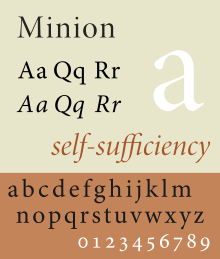 | |
| Category | Serif |
|---|---|
| Classification | Garalde old-style |
| Designer(s) | Robert Slimbach |
| Date released | 1990[1] |
Minion is a serif typeface released in 1990 by Adobe Systems. Designed by Robert Slimbach, it is inspired by late Renaissance-era type and intended for body text and extended reading. Minion's name comes from the traditional naming system for type sizes, in which minion is between nonpareil and brevier, with the type body 7pt in height.[2][3][4] As the historically rooted name indicates, Minion was designed for body text in a classic style, although slightly condensed and with large apertures to increase legibility.[5] Slimbach described the design as having "a simplified structure and moderate proportions."[6][7] The design is slightly condensed, although Slimbach has said that this was intended not for commercial reasons so much as to achieve a good balance of the size of letters relative to the ascenders and descenders.[3]
Minion was developed into a large family using sophisticated interpolation or multiple master technology to create a range of weights and optical sizes suitable for different text sizes.[8][9][10] This automation of font creation was intended to create a seamless transition of styles from solid, chunky designs for caption-size small print to more graceful and slender designs for headings.[11][a] It is an early member of what became Adobe's Originals program, which created a set of type families primarily for book and print use, many like Minion in a deliberately historical, humanist style.[b]
Minion is a very large family of fonts, including Greek, Armenian and Cyrillic alphabets, optical sizes, condensed styles and stylistic alternates such as swash capitals.[14] As a standard font in many of Adobe's programs, it is one of the most popular serif typefaces used in books. One of the most famous uses of Minion is The Elements of Typographic Style, Robert Bringhurst's book about fine printing and page layout.[15][16]
- ^ Riggs, Tamye. "The Adobe Originals Silver Anniversary Story: Expanding the Originals". Typekit. Adobe Systems. Retrieved 27 February 2017.
- ^ Phinney, Thomas (18 March 2011). "Point Size and the Em Square: Not What People Think". Phinney on Fonts.
- ^ a b Slimbach, Robert; Bringhurst, Robert. "A conversation between Robert Slimbach and Robert Bringhurst about Minion". Minion 3–Typekit. Adobe Systems. Retrieved 19 April 2018.
- ^ Slimbach, Robert. "Robert Slimbach on Minion's historical context: milestones in the evolution of old style roman typefaces". Minion 3. Typekit. Retrieved 19 June 2018.
- ^ "Minion". Typekit. Adobe. Retrieved 2 July 2015.
- ^ Slye, Christopher. "Coming to your desktop: fonts from Adobe". Typekit Blog. Adobe.
- ^ Cite error: The named reference
Arno Pro specimenwas invoked but never defined (see the help page). - ^ "DesigningMultiple Master Typefaces" (PDF). Adobe. Archived from the original (PDF) on 6 July 2015. Retrieved 2 July 2015.
- ^ Carter, Sebastian. "Typeface Review: Adobe Minion". Bulletin of the Printing Historical Society (35): 14–15, supplement issue 36 p. 15.
- ^ Lo Celso, Alejandro. "A discussion on Type Design Revivalism". PampaType. Retrieved 19 June 2018.
- ^ Riggs, Tamye. "The Adobe Originals Silver Anniversary Story". Typekit blog. Adobe. Retrieved 2 July 2015.
- ^ Phinney, Thomas (18 March 2010). "Font Remix Tools (RMX) and Multiple Master Fonts in type design". Phinney. Retrieved 4 July 2015.
- ^ Phinney, Thomas. "TrueType, PostScript Type 1, & OpenType: What's the Difference?" (PDF). Adobe. Retrieved 4 July 2015.
- ^ "Adobe Typography Primer" (PDF). Adobe. Retrieved 2 July 2015.
- ^ Coles, Stephen. "Top Ten Typefaces Used by Book Design Winners". FontFeed (archived). Archived from the original on 28 February 2012. Retrieved 2 July 2015.
- ^ Bringhurst, Robert (1996). The elements of typographic style (2. ed.). Point Roberts: Hartley & Marks. p. 49. ISBN 0881791334.
Cite error: There are <ref group=lower-alpha> tags or {{efn}} templates on this page, but the references will not show without a {{reflist|group=lower-alpha}} template or {{notelist}} template (see the help page).